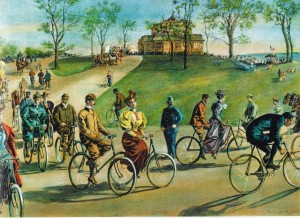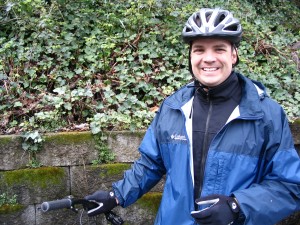Posted 9:09 p.m. Thursday, June 7, 2012

 [/caption]
As the City of La Crosse creates a master plan for bike and pedestrian traffic, it’s important to consider American bicycle history, says James Longhurst, UW-L assistant history professor.
All the pedaling seen today is nothing new. Bicycles were also booming more than 100 years ago.
“We are now in the second big bicycle boom in America,” explains Longhurst.
His research focuses on the forgotten first boom of the 1890s and early 1900s. In between horse-drawn buggies and automobiles, special paths alongside roads were made just for bikes, says Longhurst. But by the 1920s the "Good Roads" movement succeeded in paving dirt roads for all users, and the old bike paths were buried well below layers of concrete. By the end of World War II, energy was cheap and city streets were designed with the mentality that fossil fuels would always be affordable, so cars took over.
“People like to think roads were always built for cars, but it’s not true,” says Longhurst. “Cars are huge, fast and furious and they pushed everything off of the road.”
[caption id="attachment_12494" align="alignright" width="300" caption="James Longhurst, UW-L assistant history professor, tours bicycle lanes and accommodations of Portland, Oregon, with historians and representatives of the Portland Bureau of Transportation in 2010."]
[/caption]
As the City of La Crosse creates a master plan for bike and pedestrian traffic, it’s important to consider American bicycle history, says James Longhurst, UW-L assistant history professor.
All the pedaling seen today is nothing new. Bicycles were also booming more than 100 years ago.
“We are now in the second big bicycle boom in America,” explains Longhurst.
His research focuses on the forgotten first boom of the 1890s and early 1900s. In between horse-drawn buggies and automobiles, special paths alongside roads were made just for bikes, says Longhurst. But by the 1920s the "Good Roads" movement succeeded in paving dirt roads for all users, and the old bike paths were buried well below layers of concrete. By the end of World War II, energy was cheap and city streets were designed with the mentality that fossil fuels would always be affordable, so cars took over.
“People like to think roads were always built for cars, but it’s not true,” says Longhurst. “Cars are huge, fast and furious and they pushed everything off of the road.”
[caption id="attachment_12494" align="alignright" width="300" caption="James Longhurst, UW-L assistant history professor, tours bicycle lanes and accommodations of Portland, Oregon, with historians and representatives of the Portland Bureau of Transportation in 2010."] [/caption]
Longhurst notes these days it has been difficult to reintroduce bicycles to city streets, which have long been dominated by cars. He has been volunteering to assist with updating La Crosse’s Bicycle and Pedestrian Master Plan, which aims to help the city move from a silver to a gold designation as established by the League of American Bicyclists. The plan will likely be introduced to the public in September.
He praises La Crosse for creating a master plan that involves bikes. Some cities simply have short-term solutions to accommodate what they consider to be a bike fad.
The cities with the best bike plans have had long-term infrastructure for bikes in place, he says. For instance, Minneapolis is routinely ranked No. 1 in the nation for best bicycling city— despite being below zero for a good portion of the year. That city’s 2010 bicycle master plan acknowledges its bike history — noting the bicycle will always be part of the culture, says Longhurst. Some of the historic bike paths are still around Minneapolis, he adds. Longhurst has been researching the history of bicycling in the Twin Cities and other cities such as Rochester, N.Y., and Chicago, which were shaped a century ago to be friendly to bikes and pedestrians. Some adapted well keeping bike paths; others covered them up.
Longhurst encourages cities to consider this history and have street designs that allow for walking, biking, public transit and cars, considering energy will likely never be as cheap as it was in post-World War II America.
“We can’t predict the future, so our plans should be as flexible as possible,” he says.
[/caption]
Longhurst notes these days it has been difficult to reintroduce bicycles to city streets, which have long been dominated by cars. He has been volunteering to assist with updating La Crosse’s Bicycle and Pedestrian Master Plan, which aims to help the city move from a silver to a gold designation as established by the League of American Bicyclists. The plan will likely be introduced to the public in September.
He praises La Crosse for creating a master plan that involves bikes. Some cities simply have short-term solutions to accommodate what they consider to be a bike fad.
The cities with the best bike plans have had long-term infrastructure for bikes in place, he says. For instance, Minneapolis is routinely ranked No. 1 in the nation for best bicycling city— despite being below zero for a good portion of the year. That city’s 2010 bicycle master plan acknowledges its bike history — noting the bicycle will always be part of the culture, says Longhurst. Some of the historic bike paths are still around Minneapolis, he adds. Longhurst has been researching the history of bicycling in the Twin Cities and other cities such as Rochester, N.Y., and Chicago, which were shaped a century ago to be friendly to bikes and pedestrians. Some adapted well keeping bike paths; others covered them up.
Longhurst encourages cities to consider this history and have street designs that allow for walking, biking, public transit and cars, considering energy will likely never be as cheap as it was in post-World War II America.
“We can’t predict the future, so our plans should be as flexible as possible,” he says.
